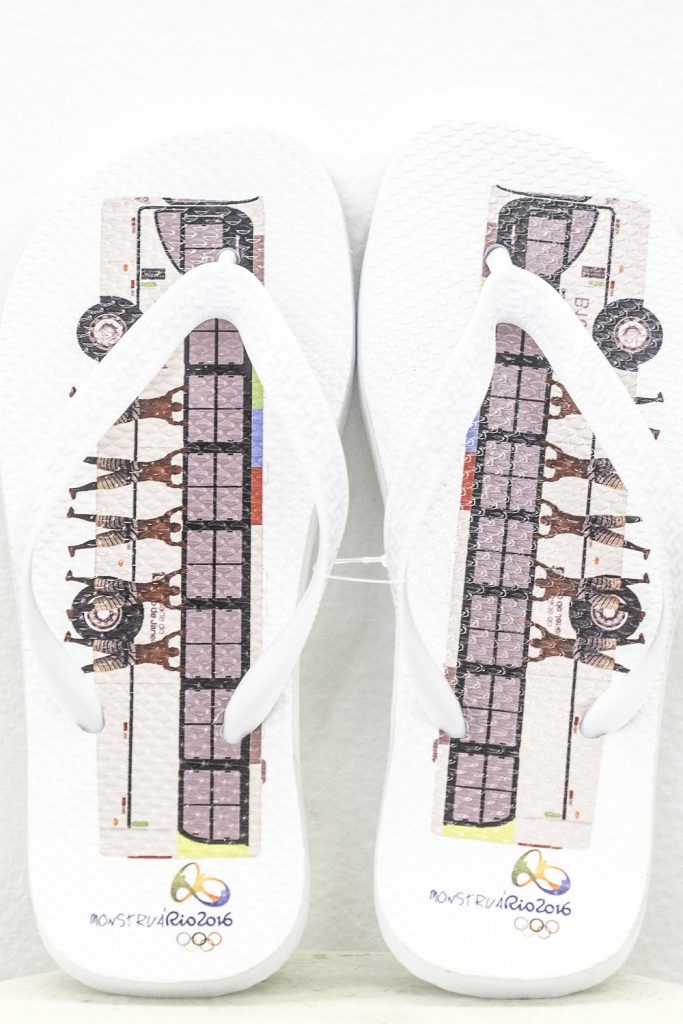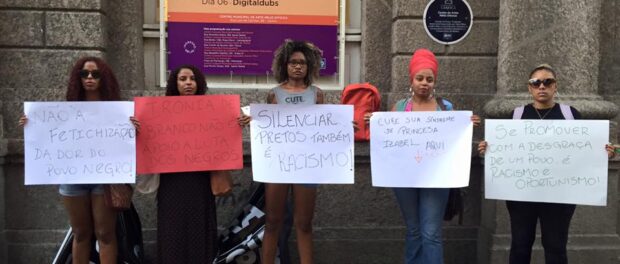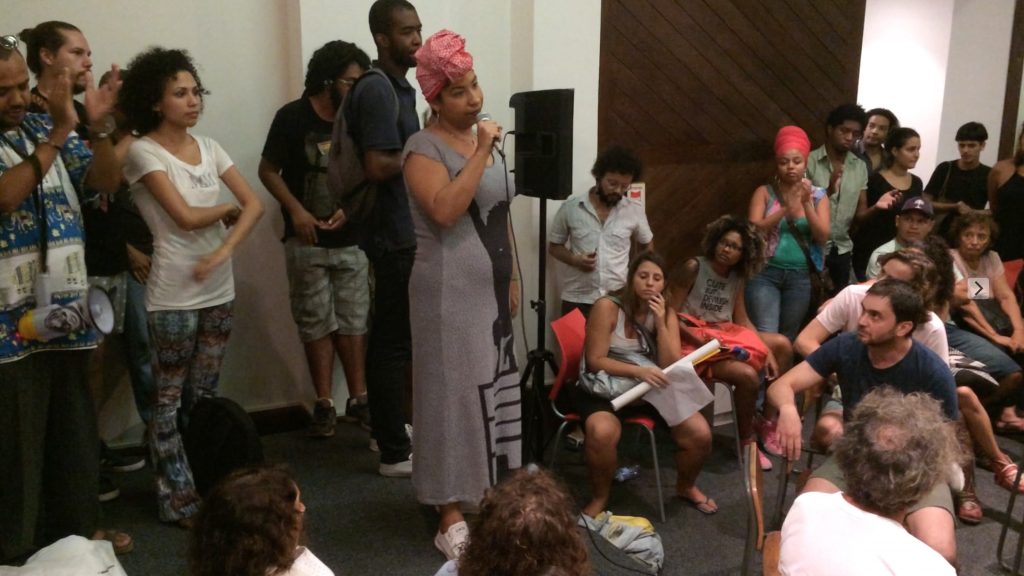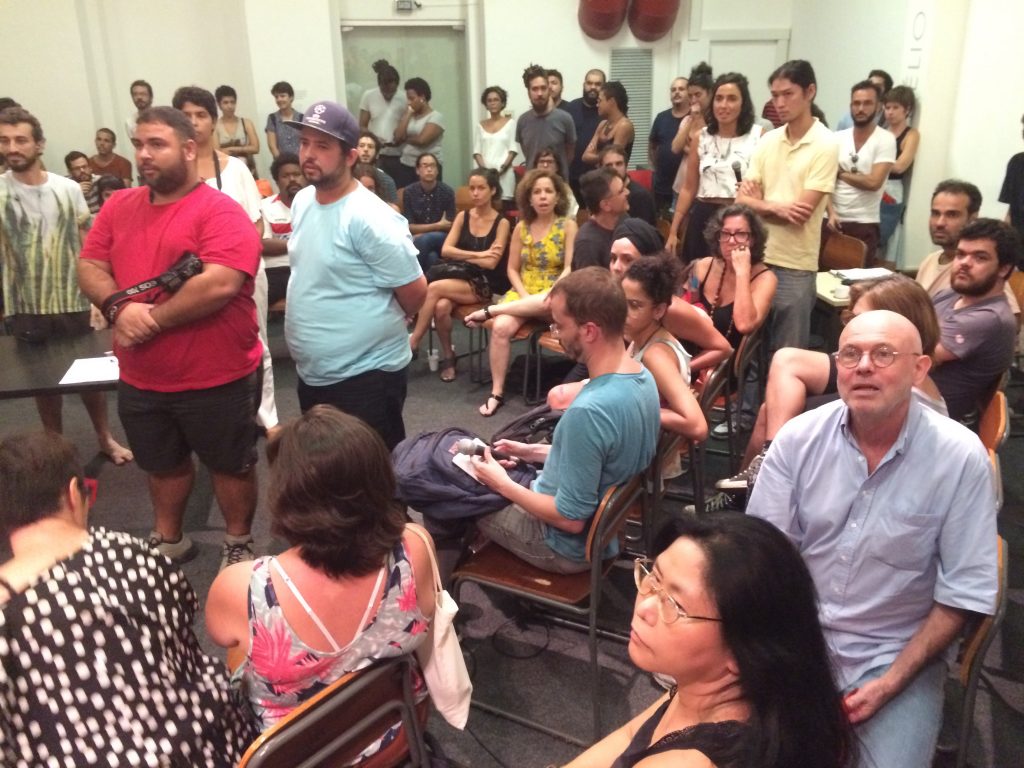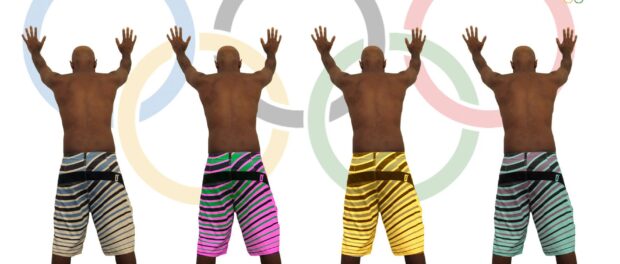
The anti-Olympics MonstruáRio 2016 exhibit by Rio de Janeiro comedian Rafucko, an “anti-souvenir shop” for the upcoming 2016 Olympic Games, has been accused of racism by Black activists for appropriating and exploiting the struggles of Black people in the city.
The MonstruáRio 2016 exhibit simulates a real souvenir shop selling items with imagery of Black favela youth, and forced evictions caused by the Rio 2016 Olympics. Rafucko’s intention was to “reproduce and reveal the commercial logic that transforms the city of Rio in an amusement park for the few at the same time that Black youth are continually slaughtered.” For Rafucko, the souvenirs would serve as ironic reminders of the human rights violations that have resulted from mega-event hosting; celebratory plates depict the military interventions in Maré and stuffed bulldozer cuddly toys represent evictions in Rio’s vulnerable communities. The exhibit-shop opened on April 2 at the Hélio Oiticica Municipal Center of Art in downtown Rio as part of the collective ComPosições Políticas (Political Compositions), product of an intensive four week art workshop in Complexo da Maré.
Rio resident Rafael Puetter, or Rafucko, first began his performances on YouTube in 2008. In 2011, he gained momentum as a progressive comedian making fun of conservative segments of Brazilian society. During the 2013 protests, Rafucko held discussions on police violence and was eventually arrested during one of the many mass protests that year. Rafucko saw the protests as a crucial moment where social movements could merge. “Police violence, that affected mainly favela residents, is now in formal Rio. The movements can now fight together,” said Rafucko, leading to the creation of the MonstruáRio 2016 exhibit.

In the promotional video for the exhibit, Rafucko goes over the items for sale. We see an “Apartheid” postcard portraying four barefoot Black youth wearing swim trunks, assuming the “stop and frisk” position with their hands against an Olympics-logo wall. Another item for sale is a 111-piece Costa Barros puzzle, referring to last year’s incident where police shot 111 times and killed five Black youth on their ride home in Costa Barros, located in the North Zone. The sales pitch is sprinkled with satire and light-hearted elevator music plays in the background. Rafucko attempted to expose the naturalized state of violence against poor Black youth.
Following the release of Rafucko’s promotional video, which garnered close to a million Facebook views, Black activists began to voice their protests. Robin Batista published an article titled “Black and peripheral pain as souvenir for white progressives” examining current limitations of white progressives in regards to racism. For Batista, recognizing and denouncing the pain inflicted on Black people does not make one immune to exploiting the Black community. “It is like this in almost every progressive space: to not be racist, whites mention racism as a way to avoid its discussion,” wrote Batista. He added: “While it’s common to see white progressives referring to racism, it’s rare to see their articulation of actual practices in order to fight it. The point is, in these progressive spaces, racism serves a purpose: to be a souvenir.”
Lawyer and activist Laura Astrolabio dos Santos wrote on Facebook why “whitesplaining” is a form of racism: “White progressives insist that, when we call them out on racism, they should be the final arbiters whether it was racism or not…. White allies must be aligned with what we want and what we think, they need to have empathy and not just assume that they know how to help us. Whitesplaining needs to end. We know how to speak and we do not want this exhibit and anything else like it.”
Activist Stephanie Ribeiro criticized Rafucko’s attempted “cleverness” of the art exhibit: “In 1885,” Ribeiro said in her Facebook post, “Marc Ferrez would photograph slaves and make postcards out of them, building his success by selling this ‘exotic’ imagery to Europeans. Rafucko reproduces the same kind of logic and enters the long list of those ‘well-intentioned’ racists.”
In response to the strong criticism of his exhibit, Rafucko replied with a public apology on his Facebook page on April 10: “I’m a middle class white man and I am not a direct target of this violence. But it targets me as a human being. I’m aware the I am co-responsible for this dynamic because the bullets used to kill are financed by us. I apologize to those who were offended. I recognize that I should have reflected more during the creative process. I hope that you will all see that there is space for all in the fight for human rights.”
He goes on to explain that “despite the products being for sale, there is no profit: money from sales serves to cover production, which was paid with my resources from the artistic residency. The project is product of a residency realized during the month of March, with 11 other artists, 6 of them from favelas and 6 from other zones in the city. The selling of items, in a space belonging to City government, is also a criticism of the State that insists on selling the city of Rio de Janeiro as marvelous, even in the midst of so much blood and pain. I used the official Olympics logo to make it very clear that the memory of this event must also include those who were excluded from the big party, either through eviction from their homes or the loss of their own lives or of dear friends.”
Many others showed their support for Rafucko’s artistic freedom. One notable supporter was Brazilian cartoonist Carlos Latuff, popular for his drawings against the Israeli state and police violence. In a comment on Rafucko’s Facebook post, Latuff argued that art should not be censored and Rafucko’s race and social class weren’t important compared to the artistic product itself. “We don’t need to be poor and Black favela residents in order to express solidarity for them,” concluded Latuff. Naldinho Lourenço, of photography collective Imagens do Povo, echoes Latuff, saying, “To focus solely on Rafucko and forgetting that there are twelve of us participating in the exhibition, including six favela residents, means to repress us in a space historically occupied by elites. Censoring is what we have to go through every day in favelas.”
Neither Rafucko’s apology nor the social media support for the exhibit were enough to pacify critics. Activists organized a Facebook event called “Demonstration against MonstruáRio 2016 exhibit” for April 12 at the Hélio Oiticica Municipal Center of Art where Rafucko’s exhibit was on display. When hundreds were confirmed for the demonstration, Rafucko announced an open debate at 4pm on the same day and at the same location, overlapping with the activists’ scheduled demonstration.
Many protesters entered the auditorium housing the debate, while others stood outside holding signs, blowing whistles, and speaking through loudspeakers. Signs read: “Stop fetishizing Black people’s pain,” “White irony does not support the Black cause,” and “Silencing Blacks is also racism!”
While the debate continued with Rafucko inside, the building itself closed its doors at 6pm as it does every Tuesday. Demonstrators demanded that it be opened for the protest to act in unison. When the building security refused to open it, many climbed through an open window leading to the auditorium, including activist Laura Astrolabio do Santos. She managed to secure the microphone and spoke to Rafucko supporters and critics present:
“I’m not here to debate art. I’m here to make criticize racism. Racism isn’t just throwing a banana at us. Racism is to try to represent us and to try to speak for us. Then you refuse to listen to us and say that we are wrong. I’m Black and I’m wrong? I feel racism every day and I’m the one that’s wrong? You are the one that’s going to speak for me? You felt the same pain of seeing my mother try to bring my brother back home from the streets because his friends were getting killed off every day? Do you think the revolution is a game? Being Black here in Brazil, to be Black and poor means constantly fighting and struggling. We don’t have time to play with the ‘language games’ of the art world…
You’re Black, you’re ridiculed, end of story. You go and get a piece of debris from Vila Autódromo, make a postcard, and everybody bows down to your brilliance. I called you out on it. You [Rafucko] used oppressed Black peoples’ image and put it on sandals. Anyone who wears it will be stepping on them. Those who supported and defended you after we began our criticism were mostly White. Many of them stalk and harass Black women on social media. We received threats from them on Facebook, death threats and all the insults you can imagine. These were the people that were defending you, insulting me, and questioning my intelligence. Do you know about the law that I helped propose? Did you go to Alerj [Rio de Janeiro State Legislative Assembly] and pressure authorities to approve the law? Or are you just going to stay here selling debris from Vila Autódromo?”
Tensions were already high when the Municipal Guard showed up. Another activist addressed the crowd: “Rafucko, your work exposes what you understand as solidarity. It isn’t! It doesn’t promote our cause in any way. Now we’re forced to trespass to express ourselves and the Municipal Guard is waiting for us outside. Nothing has changed!”
For Rafucko’s critics, his good intentions as a white ally—to merge social movements and emphasize the space for all to fight for human rights—were forms of appropriating a movement that he never properly belonged to and had no authority in representing. The Black activists intervened wanting to educate the public about what to them it means to be an ally and how those from privileged positions can properly assist the underprivileged in the fight for their rights. In the same way that Rio de Janeiro’s favelas have become commodified as a brand for parties and safari-like tours, Rafucko’s progressive and well-meaning art exhibit reproduced dynamics of cultural appropriation.
This perspective holds that the regulation of artistic freedom by Black people productively enhances overall freedom by forcing the previously silenced to be heard. It is an intervention that empowers Black voices through Black voices themselves, therefore enforcing more egalitarianism on an uneven playing field. The Black movement was criticized for offending freedom and being authoritarian agents of censorship. This critique, though, reproduces the false symmetry of liberal democracies, a denial of inequality through the meritocratic tabula rasa myth where everyone has equal opportunities for success and representation. This perspective holds that when Carlos Latuff and even Black artists participating in the ComPosições Políticas exhibition called it censorship, they ultimately preserved white privilege’s mechanisms of silencing non-whites in Brazilian art and politics.
The problem with white privilege starts with its assumptions: assuming one can freely join the Black movement, assuming one can freely represent Black voices, assuming that Blacks agree on Whites inhabiting their revolutionary space.
Why wasn’t Rafucko aware that his attempt to fight against the genocide of Black favela youth could backfire? One might make the following analysis: freedom is the problem here. Rafucko had the freedom to make a series of assumptions and those assumptions resulted in a racist form of anti-Olympics activism. Laura Astrolabio’s speech criticized current progressive forms of artistic freedom and suggested a way out. When activists criticize the Rio 2016 Olympics’ faults through creative exhibits, creativity itself is at risk of falling into the same traps as reactionary discourses, namely that censorship and regulation hurt the inalienable right to freedom. In the end, freedom, from all sides of the political spectrum, is routinely used to justify exploitation of disenfranchised communities.
“Nothing has changed,” chanted the Black activists that night. But maybe something has changed. Although still far from ideal, racial justice in Brazil has never been discussed as much as it is now. The Black movement now teaches the Left that presumed alliances with them can create more harm than good, especially when they are forged at the cost of silencing those that are supposedly being empowered. Laura Astrolabio, Senzy Garcês, Robin Batista, Renato Gama, Stephanie Ribeiro, and Eduardo Santana are some of the few actors working to transform this scenario. After years of neglect, they are compelling Brazil’s Left to properly adopt racial justice, deconstructing both the blatant racism of blackface in award-winning play A Mulher do Trem and the well-intentioned fetishization of Black voices found in Rafucko’s MonstruáRio 2016.
As many progressives in Brazil now begin to be haunted by the specter of their unconscious racism, the sphere of art and its regulation emerges as an important political terrain of dispute. Eliane Brum predicted last year that the A Mulher do Trem controversy could become a model for other instances of racial justice. Exactly eleven months after the A Mulher do Trem controversy, the demonstration against Rafucko’s exhibit emerged as its younger sibling.
Laura Astrolabio and the other Black activists that night perturbed national narratives of race. As Brazil is beginning to ask itself how racist it truly is, the country is also tinkering with the pillars of democracy via conservative politicians desperately clinging onto age-old narratives amid the rapidly changing socioeconomic topography. While white allies openly fighting a Black cause might seem to many like an excellent idea, similar conservative dynamics of preserving privileges remain. Democracy comes and goes in waves. In this wave, the protest against Rafucko’s well-intentioned activism might have strengthened a fragile democracy.
*Why I capitalize the word Black.

